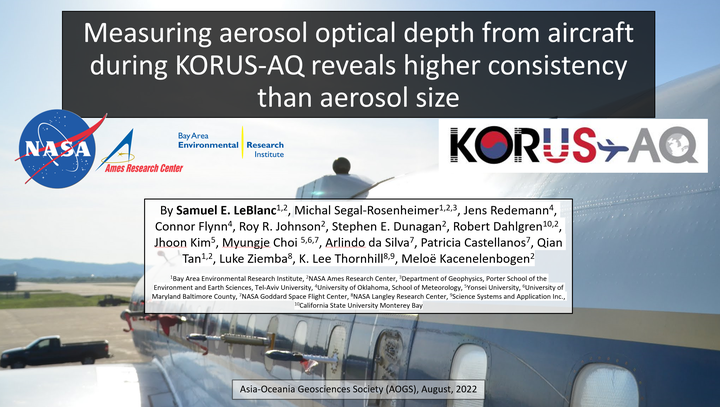Invited oral presentation during AOGS (Asia Oceania eosciences Society) 2022
 Aerosol optical depth is more spatially consistent than aerosol size
Aerosol optical depth is more spatially consistent than aerosol sizeAbstract
The airborne sunphotometer – 4STAR (Spectrometers for Sky-Scanning Sun Tracking Atmospheric Research) – measured the aerosol optical depth (AOD) spectra and trace gases from the NASA DC-8 during the KORUS-AQ (KORean-US Air Quality) experiment in May-June 2016. These measurements over Korea and the surrounding waters are obtained at high spatial and temporal resolution. We show the consistency over spatial scales of the AOD and the aerosol intensive properties, Angstrom exponent (AE) and fine mode fraction (FMF), observed by 4STAR, GOCI (Geostationary Ocean Color Imager Yonsei aerosol retrieval v2), MERRA-2 reanalysis (Modern-Era Retrospective Analysis for Research and Applications, v2), and from airborne in situ aerosol optical measurements by LARGE (NASA Langley Aerosol Research Group Experiment). The majority of AODs due to fine mode aerosol is observed at altitudes lower than 2 km and is dependent on the prevailing meteorological conditions. AE and FMF are found to be more spatially variable than AOD during all of KORUS-AQ, even when accounting for potential sampling biases. This may indicate that microphysical processes like aerosol particle formation, growth, and coagulation impact the dominant aerosol size at shorter scales than their combined effect on the aerosol optical depth by the aerosol emission, transport, and removal. Averaging between measurements and model, the distance at which the correlation to itself is reduced by 15% is 65 km for AOD, and 22.7 km for AE. While there are observational and model differences (MERRA-2 consistently shows high autocorrelation for longer distances, compared to GOCI, LARGE in situ, and 4STAR observations), the predominant factor influencing AOD and AE consistency is the meteorological period. The shortest AOD and AE consistency occur during extreme pollution period (25–31 May), and the longest consistency during the blocking (1–7 June) and stagnation (17–22 May) periods.